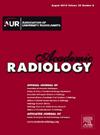CAP-Net:基于计算机断层血管造影的颈动脉斑块分割系统。
IF 3.9
2区 医学
Q1 RADIOLOGY, NUCLEAR MEDICINE & MEDICAL IMAGING
引用次数: 0
摘要
理由和目的:头颈部CT血管造影(CTA)扫描诊断颈动脉斑块通常耗时费力,导致该领域的研究有限,结果令人不快。本研究的目的是开发一种基于深度学习的模型,用于使用CTA图像检测和分割颈动脉斑块。材料和方法:1061例患者的CTA图像(男性765例;296名女性),4048个颈动脉斑块,分为75%的训练验证组和25%的独立测试组。我们构建了一个涉及三个改进的深度学习网络的工作流程:用于粗动脉分割的普通U-Net,用于细动脉分割的注意力U-Net,用于斑块分割的基于双通道输入convnext的U-Net架构,以及用于改进预测和消除误报的后处理。模型在训练-验证集上使用五倍交叉验证进行训练,并在独立测试集上使用分割和斑块检测的综合指标进行进一步评估。结果:所提出的工作流程在独立测试集(261例患者,902个颈动脉斑块)中进行了评估,动脉分割的平均dice相似系数(DSC)为0.91±0.04,每条动脉/患者的斑块分割为0.75±0.14/0.67±0.15。该模型检测出95.5%(861/902)斑块,其中钙化斑块、混合性斑块和软性斑块占96.6%(423/438)、95.3%(307/322)和92.3%(131/142),平均每例患者假阳性斑块少于1个(0.63±0.93)个。结论:本研究开发了基于CTA的颈动脉斑块自动检测与分割深度学习的CAP-Net,在斑块的识别和描绘方面取得了良好的效果。本文章由计算机程序翻译,如有差异,请以英文原文为准。
CAP-Net: Carotid Artery Plaque Segmentation System Based on Computed Tomography Angiography
Rationale and Objectives
Diagnosis of carotid plaques from head and neck CT angiography (CTA) scans is typically time-consuming and labor-intensive, leading to limited studies and unpleasant results in this area. The objective of this study is to develop a deep-learning-based model for detection and segmentation of carotid plaques using CTA images.
Materials and Methods
CTA images from 1061 patients (765 male; 296 female) with 4048 carotid plaques were included and split into a 75% training-validation set and a 25% independent test set. We built a workflow involving three modified deep learning networks: a plain U-Net for coarse artery segmentation, an Attention U-Net for fine artery segmentation, a dual-channel-input ConvNeXt-based U-Net architecture for plaque segmentation, and post-processing to refine predictions and eliminate false positives. The models were trained on the training-validation set using five-fold cross-validation and further evaluated on the independent test set using comprehensive metrics for segmentation and plaque detection.
Results
The proposed workflow was evaluated in the independent test set (261 patients with 902 carotid plaques) and achieved a mean dice similarity coefficient (DSC) of 0.91±0.04 in artery segmentation, and 0.75±0.14/0.67±0.15 in plaque segmentation per artery/patient. The model detected 95.5% (861/902) plaques, including 96.6% (423/438), 95.3% (307/322), and 92.3% (131/142) of calcified, mixed, and soft plaques, with less than one (0.63±0.93) false positive plaque per patient on average.
Conclusion
This study developed an automatic detection and segmentation deep learning-based CAP-Net for carotid plaques using CTA, which yielded promising results in identifying and delineating plaques.
求助全文
通过发布文献求助,成功后即可免费获取论文全文。
去求助
来源期刊

Academic Radiology
医学-核医学
CiteScore
7.60
自引率
10.40%
发文量
432
审稿时长
18 days
期刊介绍:
Academic Radiology publishes original reports of clinical and laboratory investigations in diagnostic imaging, the diagnostic use of radioactive isotopes, computed tomography, positron emission tomography, magnetic resonance imaging, ultrasound, digital subtraction angiography, image-guided interventions and related techniques. It also includes brief technical reports describing original observations, techniques, and instrumental developments; state-of-the-art reports on clinical issues, new technology and other topics of current medical importance; meta-analyses; scientific studies and opinions on radiologic education; and letters to the Editor.
 求助内容:
求助内容: 应助结果提醒方式:
应助结果提醒方式:


